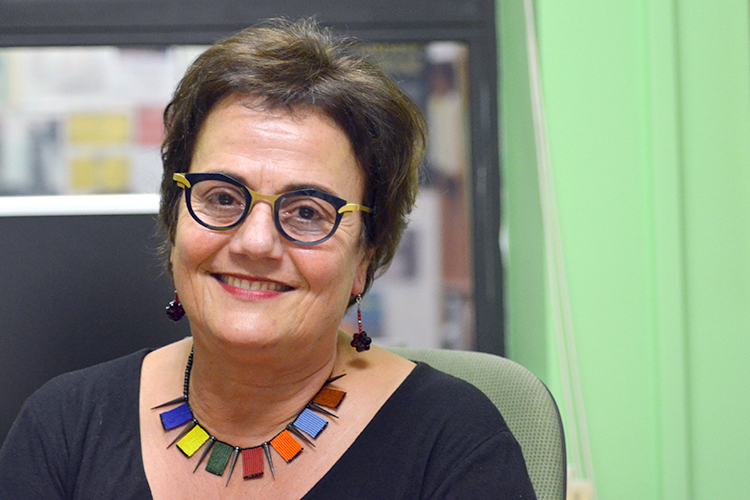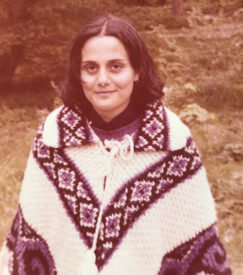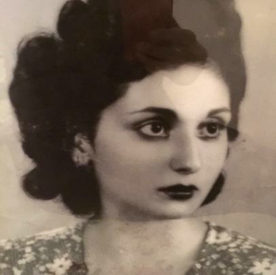I’m a Berkeleyan: Minoo Moallem on being Muslim and a feminist
"My cultural roots have influenced me enormously," says the professor in gender and women's studies. "I don’t see any contradiction between being a transnational feminist and being from a Muslim background."

March 16, 2021
“My mom was a remarkable woman, not because she was an extraordinary figure or celebrity, but because of what she made art out of. When I close my eyes, I can still smell the aroma of pickles, jams, rose water, bread and pastries. I would never consider the work of a housewife as work which has no value, but as work that is crucial for our livelihood.
She had six children. We lived in a very conservative small town in Iran, but she raised us to become very independent, very invested in education. I learned from her to engage in what I was passionate about. She always reminded us that we should become independent financially and pursue an education. And she taught my brothers how to cook. She managed to bring daughters into a space of education and public life, and her sons into the domestic space. She would tell us, ‘I’m raising you for the world.’
In 1953, a year before I was born, there was a coup d’état. Iran’s democratic government was overthrown by a dictator. It’s been well-documented that the CIA supported the coup d’état. I was a sensitive child — I was very aware of gender issues, and I was very rebellious. I challenged confining patriarchal traditions. I was invested in changing the rules and regulations, the authoritarian modernization of Iran. As a generation of women, we became invested in revolutionary ideas and ideals. We were very egalitarian. We wanted to fight for that. So, I think my passion for feminist work started in Iran, but continued in the diaspora.

Moallem in 1977, two years before the Iranian revolution, which would spur her move abroad. (Photo courtesy of Minoo Moallem)
I left Iran in 1982, a few years after the Iranian revolution of 1979. I had become disappointed with what happened after the revolution because my generation of women, we had our own ideas of what a revolution would mean, but I don’t think we achieved what some of us expected or desired, in that sense. I went to France, then Canada, and ended up in California.
When I became diasporic, I realized that being from a Muslim background was a problem. I realized that the racialization of Muslims made people consider me as someone who is ‘other.’ Each time I said I was from a Muslim background, people would ask me, ‘Are you practicing?’ Or, ‘Are you praying?’ The idea that a Muslim woman could be both feminist and secular was unimaginable to many people.
My cultural roots have influenced me enormously. I don’t see any contradiction between being a transnational feminist and being from a Muslim background. That dualism is created through the colonial project of constructing tradition vs. modernity instead of thinking of tradition as being reinvented constantly all the time. We tend to think of tradition as something that is frozen, as something dead, as something outside of history. But we rewrite traditions constantly. We rethink them. We redo and sometimes even undo them. I wrote about this complexity in a chapter called “Am I A Muslim Woman: Nationalist Reactions and Postcolonial Transactions” in the book Shattering the Stereotype: Muslim American Women, published in 2005.

Fatema Mernissi, known as a founder of Islamic feminism, accepts the Erasmus Prize in 2004. Moallem says Mernissi is among many amazing Muslim feminists who have inspired her work and life as a feminist. (Photo courtesy of the Praemium Erasmianum Foundation via Wikimedia Commons)
I became familiar with Fatema Mernissi’s work in the late 1980s when I was a Ph.D. student in Montreal. She was a Moroccan sociologist, known as a founder of Islamic feminism. She made it possible for us to think about how being a secular Muslim feminist doesn’t mean to be dismissive of religious and cultural traditions.
She inspired me, as a feminist, to live a life that was extremely meaningful because I think academic work and intellectual work are so important. And it’s also never ending. The work of thinking, the work of writing, the work of reading is never ending. I feel she created a legacy for feminists from the Muslim world, from the Arab world, from the Middle East to continue that kind of work.

Moallem says she learned from her mother to engage in what she was passionate about. “She would tell us, ‘I’m raising you for the world.’”(Photo courtesy of Minoo Moallem)
One of my older courses, maybe one of the few in the U.S., was called Women in the Muslim and Arab Worlds. I designed it in 1994. It became very popular. The first thing students would say is, ‘We had no idea that there was such a huge feminist discourse in the Muslim and Arab worlds.’ I take them to feminism as a discourse, as well as a political movement, that has emerged in various parts of the world from different historical contexts. Some of my former students are teaching similar courses today, but with different titles, so now there are many courses like the one I taught in the ‘90s.
There are various forms of resistance and resilience in Iran and across the world. Some of them are visible; some of them are not visible. Some of them are exposed; some of them are veiled. My diasporic experience teaches me that there is no space that is not messy in a rapidly changing world. We, as thinkers, as feminists, we have to constantly reflect upon our world, our becoming, our past and our future. Our thinking is never done.”
